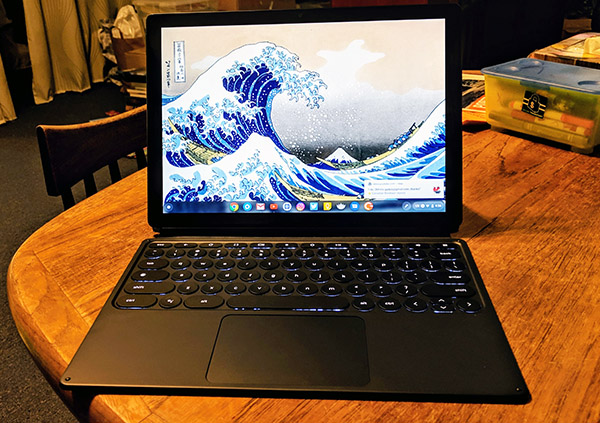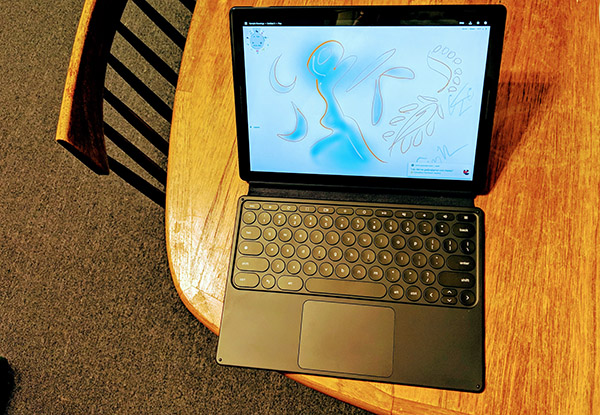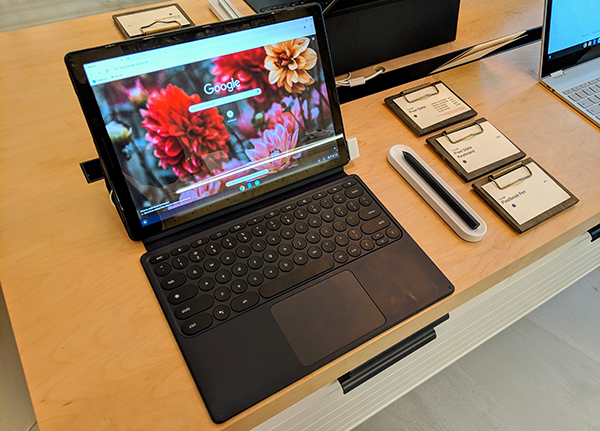The Clean Slate: The Google Pixel Slate Review
 Tuesday, November 27, 2018 at 12:52PM
Tuesday, November 27, 2018 at 12:52PM 
Anyone wanting a change from decades-old computing nuances, who is mostly web-based, and who can find Android and Linux apps to suit their needs will love this tablet.
By Gadjo Cardenas Sevilla
The Google Pixel Slate is a fresh new take on what a Google-made tablet can offer in 2018. Tablets have been a part of Google’s Nexus strategy in years past as a great adjunct to smartphones for accessing Google’s services and features.
There have been various generations of Nexus 7 and Nexus 9 tablets as well as the elusive Google Pixel C 2-in-1 which is a natural predecessor of the Pixel Slate. The big switch has been that Android was lousy on tablets, but Chrome OS, that has way more potential.
What is the Pixel Slate and who needs it?
![]()
Google surprised the world a year ago by releasing the Pixelbook, a premium convertible laptop with a stellar keyboard and trackpad as well as a sleek touchscreen and the ability to take pen input for drawing and inking. With a high-performance Intel processor and solid laptop specs, the Pixelbook remains the most premium Chromebook money can buy.
Chrome OS has also undergone massive change. Shaping the software to suit the now more versatile hardware, Chrome OS 70 now has a better tablet-mode experience. Chrome OS can also run Android apps natively and can even be coaxed into running various Linux applications.
This adds a plethora of options for Chrome OS converts who now have a fast, secure and always updated OS that can now tap into multiple ecosystems of established apps and services.
As a macOS and Windows 10 user, I’ve been able to do 80 per cent of my work on a Chromebook, which I find less distracting since it doesn’t need constant updates or virus scans. I still use my PC or Mac for audio and video production.
The Pixel Slate is a further refinement of Google’s 2-in-1 strategy. The Pixel Slate is a sleek and premium tablet 7.0mm thin tablet with a 12.3-inch LCD featuring an impressive 3000 x 2000 resolution.
The device is powered by Intel processors ranging from Celeron, Core m3, i5, and i7 processors. Its amazing that this can handle high-spec processors without the need for a fan and in a thin and light case.
Pixel Slate also features loud stereo speakers, dual mics for voice cancellation during conference calls, and can manage 12-hours of use on a single charger (which can be completed in 2 hours and 5 minutes using any of the two USB Type-C ports).
As a tablet, the Pixel Slate is thinner and comparatively lighter than the Microsoft Surface Pro but slightly heavier than the 12.9-inch Apple iPad Pro. That said, at 1.6 pounds, this isn’t an easy tablet to consider for prolonged one-handed use.
The Pixel Slate is smooth and well balanced, although it’s dark Midnight Blue aluminum finish is a fingerprint magnet. I used my Pixel Slate review unit (a Core i5 model with 8GB of RAM and 128 GB of storage) almost exclusively with the optional Google Pixel Slate Keyboard.
A Keyboard worth considering![]()
Since the Pixel Slate is a Chromebook, its natural habitat is in laptop mode. In order to make it useful, it requires a great keyboard.
Google really outdid itself with the Google Pixel Slate Keyboard. Not only is it a lightweight and low-profile keyboard cover, it is a great keyboard period.
Featuring larger rounded ultra-quiet keys with great tactile travel, the Pixel Slate Keyboard is easy to get used to. Google even managed to get backlighting on this keyboard, something the iPad Pro Keyboard Cover does not have.
The magnetic cover can also easily be adjustable to support laptop, tablet, entertainment mode. It’s not as secure as the Surface Pro keyboard, which has a way to angle the keyboard for better ergonomics.
Typing on the Pixel Slate Keyboard is nothing short of delightful and the circular keys do help give a larger area of coverage. Google has managed to create an outstanding accessory keyboard that will impress event the most discerning touch typists.
![]()
While I still prefer the solid-feel and ergonomics of the Pixelbook, which has been my daily driver for a few weeks now, the Pixel Slate will serve users well for prolonged periods of typing.
Using the optional Pen, I’ve been able to write on the screen, encircle objects or logos (which quickly triggers Google Image search) and draft sketches and simulate painting.
I’d say the Pixel Slate is as good as the Surface Pro 4 for inking, but there is still perceptible latency where it takes a split second for a line you drew to show up on the screen. I think this is more on the apps than the hardware.
Using the Pixel Slate
![]()
There are laptop people and there are also tablet people. Which one you are will dictate the best product for you. While I think the Pixel Slate is a desirable and super versatile tablet, I don’t see myself replacing my Google Pixelbook with it anytime soon.
The Pixel Slate makes a great choice for a second device to a desktop or notebook, an entertainment hub that can handle some light productivity computing on-the-go.
During my use, I found it to be a solid desktop device for writing, surfing the web and catching up on email. The backlit keyboard and the mouse on this device are rock solid and set a new standard for tablet keyboard folio cases.
The large display is great for multiple windows and for immersing in apps and content. I like the Pixel Imprint fingerprint reader, it's faster than many face recognition solutions in the market.
The Pixel Slate’s display is also impressive and superb for consuming content. I was glued to Netflix watching Fantastic Beasts and Where to Find Them as well as Star Wars: The Last Jedi and I was impressed by the video as well as the stereo surround sound. I also tried some racing games and found performance to be good.
What completes the Pixel Slate experience is really the Keyboard Case which, complete with backlit keyboard keys and a responsive mouse, really elevate this tablet into a powerful and formidable Chrome OS laptop.
Chrome OS 70 may seem new, but it is quite exceptional. Fast, secure and versatile, it is a viable option to Windows and macOS for open minded people willing to give it a chance.
Perfect timing
The Pixel Slate comes at the right time. Yes, there are competing tablet-based 2-in-1 devices out there, but they come with a lot of baggage.
The new iPad Pro is being lauded for its hardware but even the biggest fanboys are realizing that iOS needs a huge overhaul to really operate on the level of a PC or a laptop. Lack of multitasking, windows, file system or the ability to access files aside from photos and videos from external drives are huge stumbling blocks.
Surface Pro devices are great and now even more powerful, but they’re still mired by PC baggage. Viruses, incessant software and firmware updates, files getting lost, blue screens, are still part of the Windows experience, unfortunately.
This is where the Pixel Slate slides in so nicely. It is a 2-in-1 tablet, it can do laptop things and it can handle productivity and creative tasks, but it is devoid of legacy baggage. In tablet form, it is more palatable and desirable than a laptop-based Chromebook, but it is still very much a Chromebook.
That, to answer the question at the start of this review, is the Google Pixel Slate. As for who needs it, anyone wanting a change from decades-old computing nuances, who is mostly web-based, and who can find Android and Linux apps to suit their needs will love this tablet.
Pros:
- Outstanding build and design with a spectacular display and loud speakers
- Wide range of powerful processors and storage capacities
- Runs Chrome OS as well as Android and Linux apps
- Keyboard Case (sold separately) has solid and useful backlit keys and trackpad
- Chrome OS 70 is touch-focused and intuitive
Cons:
- Pricey for a Chrome tablet
- Chrome OS in tablet mode leaves a lot to b desired
- Keyboard Case is an essential part that is sold separately
- Pen input is good but not yet great
Conclusion:

The Pixel Slate can be an attractive entry point into the Chrome ecosystem. While there are productivity-focused Chrome OS tablets out there, there’s nothing remotely as premium or as bespoke as what Google has made with the Pixel Slate.
Rating: 4 out of 5




















Reader Comments